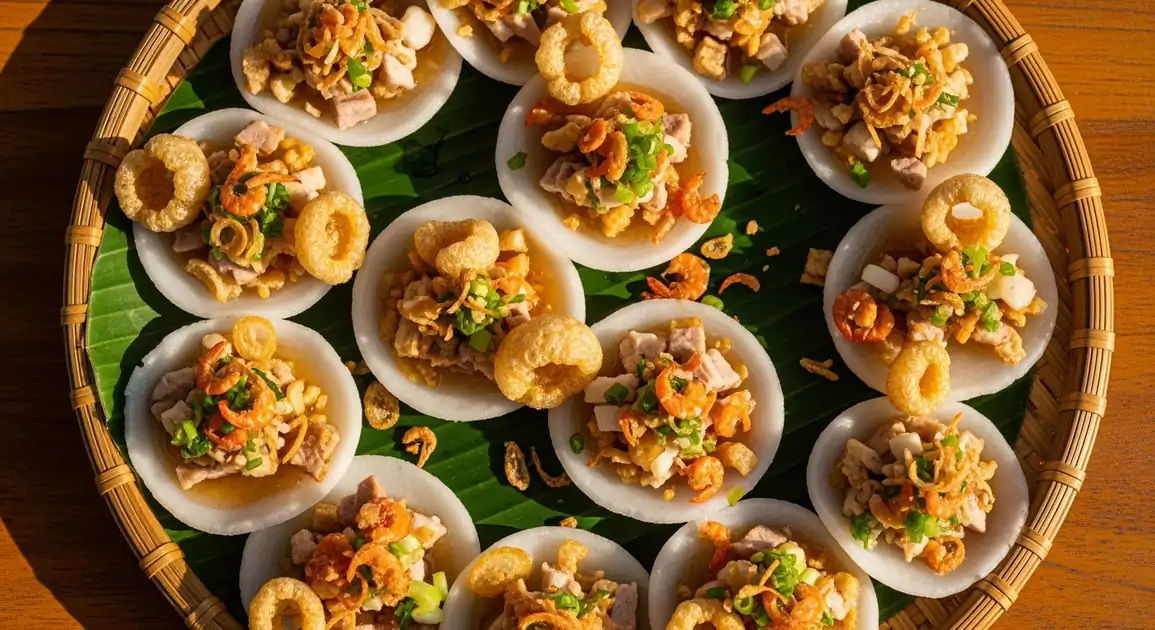Bánh Bèo (Steamed Rice Cakes)
Bánh Bèo

Description
Bánh Bèo is predominantly associated with Central Vietnam, particularly Huế where it originated, but has spread throughout the country with regional adaptations. In the north, it's typically served as part of a meal, while in Central Vietnam it's often enjoyed as a snack or appetizer. The quality of ingredients and preparation methods can vary significantly between regions.
Dietary Information
Serving information
Serving style
Traditionally served in small ceramic dishes (chen) with a small spoon. A typical serving includes 8-10 pieces. Sometimes accompanied by Vietnamese tea. In more casual settings, plastic dishes might replace ceramic.
Quick facts
Most vendors operate from 10 AM - 8 PM, with peak hours in the afternoon (2 PM - 5 PM) and early evening (6 PM - 8 PM).
Safety Tips
What to Look For
-
Freshly steamed rice cakes with slight transparency
Fresh Bánh Bèo should be steamed recently, with cakes that are slightly translucent, tender to the touch, and not dried out or cracked around the edges.
-
Clean, separate preparation areas for raw and cooked ingredients
Reputable vendors maintain hygiene with separate workstations for preparation and serving, using different utensils for raw and cooked items.
-
Fish sauce dressing made to order or properly refrigerated
The fish sauce dressing (nước chấm) should be prepared fresh or stored in refrigerated containers, not left sitting out in warm temperatures.
-
Bright, fresh-looking toppings
Toppings should appear fresh - bright green scallions, golden (not dark brown) fried shallots, and crispy (not soggy) pork cracklings.
What to avoid
-
Pre-made rice cakes sitting out unrefrigerated for long periods
Rice cakes that sit at ambient temperature for extended periods can develop harmful bacteria. Avoid vendors with large batches made well in advance without proper storage.
-
Toppings that look old, discolored, or oxidized
Dried shrimp should be pinkish-orange, not brown; scallions should be bright green, not wilted; fried shallots should be golden, not dark brown or soggy.
-
Unclean serving dishes or utensils
The ceramic dishes should be thoroughly cleaned between uses. Avoid places where dishes appear dirty or are simply wiped instead of properly washed.
-
Fish sauce dressing sitting out in warm temperatures
The dressing contains perishable ingredients that can spoil quickly in heat. Avoid places where large batches sit unrefrigerated for extended periods.
Price information
Price range
Budget tips
- Street vendors and market stalls offer the best value, typically 15,000-30,000 VND per serving.
- A serving usually includes 8-10 pieces, enough for a light meal or shared appetizer.
- Restaurants in tourist areas may charge 40,000-60,000 VND for essentially the same dish.
- Many vendors offer combo deals with other small dishes (like Bánh Nậm or Bánh Bột Lọc) for better value.
Value indicators
- Freshly steamed rather than pre-made and reheated.
- Generous toppings covering most of the rice cake surface.
- Complimentary extras like pickled vegetables or tea.
- Homemade fish sauce dressing with balanced flavors.
- Clean, individual ceramic dishes rather than plastic substitutes.
Where to Find This Dish
Local Markets
Food courts within traditional markets offer authentic versions at reasonable prices.
Đông Ba Market, Cồn Market, Hàn Market
Morning, Afternoon
Tourist Areas
Restaurants and street food areas in tourist zones offer more accessible but sometimes pricier versions.
Walking Streets, Backpacker Areas, Night Markets
Evening, Night
Residential Neighborhoods
Small family-run shops in residential areas often serve the most authentic versions to primarily local clientele.
Local neighborhoods away from tourist centers
Afternoon, Early Evening
Vendor Tips
- Look for vendors using traditional ceramic dishes rather than plastic.
- Vendors with active steamers indicate freshly made rice cakes.
- Places displaying 'Bánh Bèo Huế' typically prepare the more traditional version.
- Vendors with refrigerated or covered toppings generally maintain better food safety.
How to Order
Regional Variations
-
Bánh Bèo Chen
(Bánh Bèo Chen)
The traditional Huế style served in individual small ceramic cups (chen), topped with crushed dried shrimp, pork cracklings, scallion oil, and fish sauce dressing.
-
Bánh Bèo Đĩa
(Bánh Bèo Đĩa)
Multiple rice cakes served on a single plate (đĩa) rather than individual cups, popular in Đà Nẵng and other areas outside Huế.
-
Bánh Bèo Chay
(Bánh Bèo Chay)
Vegetarian version with plant-based toppings, typically using mushrooms instead of dried shrimp, omitting pork cracklings, and using soy-based sauce instead of fish sauce.
-
Bánh Bèo with Prawns
(Bánh Bèo Tôm Tươi)
A premium version using fresh prawns instead of or in addition to dried shrimp, sometimes found in upscale restaurants.
-
Bánh Bèo with Mung Bean
(Bánh Bèo Đậu Xanh)
A variation that includes a layer of mashed mung bean paste between the rice cake and toppings, adding extra texture and flavor.
Cultural context
History
Originating in the imperial city of Huế, Bánh Bèo dates back to the Nguyen Dynasty (1802-1945) when it was served as a delicate appetizer in royal cuisine. The name 'bèo' refers to water ferns or duckweed, reflecting the dish's appearance. Over time, it became popular throughout Central Vietnam, especially in Huế and Đà Nẵng, with regional variations developing. Today, it represents the refined culinary tradition of Central Vietnam, notable for its precise preparation and balanced flavors in a small package.
Local significance
Bánh Bèo represents the refined culinary heritage of Central Vietnam, particularly Huế's imperial cuisine. It exemplifies the Vietnamese appreciation for delicate flavors and textures in small, artfully presented portions.
Eating customs
- Add fish sauce dressing to taste before eating.
- Use the provided small spoon to loosen the cake from the dish before eating.
- Consume each piece in one or two bites to experience all flavors together.
- Tea is the traditional accompaniment, helping cleanse the palate between bites.